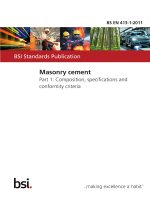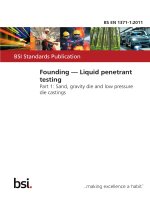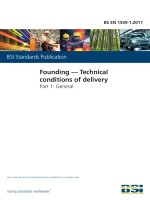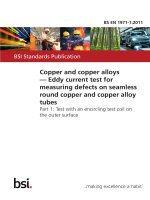Bsi bs en 61746 1 2011 (2014)
Bạn đang xem bản rút gọn của tài liệu. Xem và tải ngay bản đầy đủ của tài liệu tại đây (1.95 MB, 94 trang )
BS EN 61746-1:2011
Incorporating corrigendum September 2014
BSI Standards Publication
Calibration of optical
time-domain reflectometers
(OTDR)
Part 1: OTDR for single-mode fibres
BS EN 61746-1:2011 BRITISH STANDARD
Foreword
This British Standard is the UK implementation of EN 61746-1:2011,
incorporating corrigendum September 2014. It is identical to
IEC 61746-1:2009. It supersedes BS EN 61746:2005, which is withdrawn.
The UK participation in its preparation was entrusted to Technical
Committee GEL/86, Fibre optics.
A list of organizations represented on this committee can be obtained on
request to its secretary.
This publication does not purport to include all the necessary provisions of
a contract. Users are responsible for its correct application.
© The British Standards Institution 2014. Published by BSI Standards
Limited 2014
ISBN 978 0 580 88108 4
ICS 33.180.01
Compliance with a British Standard cannot confer immunity from
legal obligations.
This British Standard was published under the authority of the
Standards Policy and Strategy Committee on 30 June 2011.
Amendments/corrigenda issued since publication
Date Text affected
30 November 2014 Implementation of CENELEC corrigendum
September 2014: Supersession information
updated
EUROPEAN STANDARD EN 61746-1
NORME EUROPÉENNE
EUROPÄISCHE NORM March 2011
ICS 33.180.01 Incorporating corrigendum September 2014
English version
Calibration of optical time-domain reflectometers (OTDR) -
Part 1: OTDR for single-mode fibres
(IEC 61746-1:2009)
Étalonnage des réflectomètres optiques Kalibrierung optischer
dans le domaine temporel (OTDR) - Rückstreumessgeräte (OTDR) -
Partie 1: OTDR pour fibres unimodales Teil 1: OTDR für Einmodenfasern
(CEI 61746-1:2009) (IEC 61746-1:2009)
This European Standard was approved by CENELEC on 2011-01-02. CENELEC members are bound to comply
with the CEN/CENELEC Internal Regulations which stipulate the conditions for giving this European Standard
the status of a national standard without any alteration.
Up-to-date lists and bibliographical references concerning such national standards may be obtained on
application to the Central Secretariat or to any CENELEC member.
This European Standard exists in three official versions (English, French, German). A version in any other
language made by translation under the responsibility of a CENELEC member into its own language and notified
to the Central Secretariat has the same status as the official versions.
CENELEC members are the national electrotechnical committees of Austria, Belgium, Bulgaria, Croatia, Cyprus,
the Czech Republic, Denmark, Estonia, Finland, France, Germany, Greece, Hungary, Iceland, Ireland, Italy,
Latvia, Lithuania, Luxembourg, Malta, the Netherlands, Norway, Poland, Portugal, Romania, Slovakia, Slovenia,
Spain, Sweden, Switzerland and the United Kingdom.
CENELEC
European Committee for Electrotechnical Standardization
Comité Européen de Normalisation Electrotechnique
Europäisches Komitee für Elektrotechnische Normung
Management Centre: Avenue Marnix 17, B - 1000 Brussels
© 2011 CENELEC - All rights of exploitation in any form and by any means reserved worldwide for CENELEC members.
Ref. No. EN 61746-1:2011 E
BS EN 61746-1:2011
EN 61746-1:2011 - 2 -
Foreword
The text of document 86/347/FDIS, future edition 1 of IEC 61746-1, prepared by IEC TC 86, Fibre optics,
was submitted to the IEC-CENELEC parallel vote and was approved by CENELEC as EN 61746-1 on
2011-01-02.
This European Standard supersedes EN 61746:2005.
The main technical changes to EN 61746:2005 are:
– the adaptation of Clause 4;
– the deletion of Clause 10;
– the adaptation of some definitions and calculations;
– the change of graphical symbology to IEC/TR 61930.
Attention is drawn to the possibility that some of the elements of this document may be the subject of
patent rights. CEN and CENELEC shall not be held responsible for identifying any or all such patent
rights.
The following dates were fixed:
– latest date by which the EN has to be implemented (dop) 2011-10-02
at national level by publication of an identical
national standard or by endorsement
– latest date by which the national standards conflicting (dow) 2014-01-02
with the EN have to be withdrawn
Annex ZA has been added by CENELEC.
__________
Endorsement notice
The text of the International Standard IEC 61746-1:2009 was approved by CENELEC as a European
Standard without any modification.
In the official version, for Bibliography, the following notes have to be added for the standards indicated:
[2] IEC 60793-1-1 NOTE Harmonized as EN 60793-1-1.
[3] IEC 60794-1-2:2003 NOTE Harmonized as EN 60794-1-2:2003 (not modified).
[4] IEC 60825-1 NOTE Harmonized as EN 60825-1.
[5] IEC 60825-2 NOTE Harmonized as EN 60825-2.
[6] IEC 61280-1-3:1998 NOTE Harmonized as EN 61280-1-3:1999 (not modified).
[7] IEC 61300-3-2 NOTE Harmonized as EN 61300-3-2.
[8] IEC 61300-3-6 NOTE Harmonized as EN 61300-3-6.
__________
BS EN 61746-1:2011
- 3 - EN 61746-1:2011
Annex ZA
(normative)
Normative references to international publications
with their corresponding European publications
The following referenced documents are indispensable for the application of this document. For dated
references, only the edition cited applies. For undated references, the latest edition of the referenced
document (including any amendments) applies.
NOTE When an international publication has been modified by common modifications, indicated by (mod), the relevant EN/HD
applies.
Publication Year Title EN/HD Year
IEC 60793-1-40 - -
(mod) Optical fibres - EN 60793-1-40
- Part 1-40: Measurement methods and test -
IEC 60793-2-50 procedures - Attenuation
- -
ISO/IEC 17025 2004 Optical fibres - EN 60793-2-50 -
Part 2-50: Product specifications - Sectional
ITU-T 2002 specification for class B single-mode fibres -
Recommendation
G.650.1 General requirements for the competence of EN ISO/IEC 17025
ITU-T testing and calibration laboratories
Recommendation
G.650.2 Definitions and test methods for linear, -
deterministic attributes of single-mode fibre
and cable
Definitions and test methods for statistical and -
non-linear related attributes of single-mode
fibre and cable
– 2 – BS EN 61746-1:2011
61746-1 © IEC:2009(E)
CONTENTS
INTRODUCTION . ..................................................................................................................................8
1 Scope ...............................................................................................................................................9
2 Normative references.....................................................................................................................9
3 Terms, definitions and symbols . ...................................................................................................9
4 Preparation for calibration ...........................................................................................................16
4.1 Organization . ......................................................................................................................16
4.2 Traceability. ........................................................................................................................16
4.3 Preparation. ........................................................................................................................16
4.4 Test conditions . .................................................................................................................16
4.5 Documentation ...................................................................................................................16
5 Distance calibration – General . ..................................................................................................17
5.1 General . ..............................................................................................................................17
5.2 Location deviation model ..................................................................................................17
5.3 Using the calibration results . ............................................................................................19
5.4 Measuring fibre length . .....................................................................................................19
6 Distance calibration methods . ....................................................................................................20
6.1 General . ..............................................................................................................................20
6.2 External source method . ...................................................................................................20
6.2.1 Short description and advantage ........................................................................20
6.2.2 Equipment . ............................................................................................................20
6.2.3 Calibration of the equipment . .............................................................................21
6.2.4 Measurement procedure . ....................................................................................22
6.2.5 Calculations and results . .....................................................................................23
6.2.6 Uncertainties . .......................................................................................................24
6.3 Concatenated fibre method . .............................................................................................25
6.3.1 Short description and advantages . ....................................................................25
6.3.2 Equipment . ............................................................................................................25
6.3.3 Measurement procedures. ...................................................................................27
6.3.4 Calculations and results . .....................................................................................27
6.3.5 Uncertainties . .......................................................................................................28
6.4 Recirculating delay line method. ......................................................................................29
6.4.1 Short description and advantage ........................................................................29
6.4.2 Equipment . ............................................................................................................29
6.4.3 Measurement procedure . ....................................................................................31
6.4.4 Calculations and results . .....................................................................................31
6.4.5 Uncertainties . .......................................................................................................32
7 Loss calibration – General . ........................................................................................................33
7.1 General . ..............................................................................................................................33
7.2 Determination of the displayed power level F . ...............................................................33
7.3 Selection of an appropriate reference loss Aref . ...........................................................34
7.4 Development of a test plan . .............................................................................................35
7.5 Polarization dependence...................................................................................................37
7.6 Calculation of the calibration results................................................................................38
7.7 Using the calibration results . ............................................................................................38
8 Loss calibration methods ............................................................................................................38
BS EN 61746-1:2011 – 3 –
61746-1 © IEC:2009(E)
8.1 General . ..............................................................................................................................38
8.2 Fibre standard method . .....................................................................................................39
8.2.1 Short description and advantage ........................................................................39
8.2.2 Equipment . ............................................................................................................39
8.2.3 Measurement procedure . ....................................................................................40
8.2.4 Calculations and results . .....................................................................................41
8.2.5 Uncertainties . .......................................................................................................41
8.3 External source method (see Figure 16). ........................................................................42
8.3.1 Short description and advantage ........................................................................42
8.3.2 Equipment . ............................................................................................................42
8.3.3 Calibration of the reference loss. ........................................................................43
8.3.4 Measurement procedure . ....................................................................................44
8.3.5 Calculations and results . .....................................................................................45
8.3.6 Uncertainties . .......................................................................................................45
8.4 Splice simulator method. ...................................................................................................46
8.4.1 Short description and advantage ........................................................................46
8.4.2 Equipment . ............................................................................................................46
8.4.3 Procedure . .............................................................................................................47
8.4.4 Calculations and results . .....................................................................................49
8.4.5 Uncertainties . .......................................................................................................49
8.5 Power reduction method ...................................................................................................50
8.5.1 Short description and advantage ........................................................................50
8.5.2 Equipment . ............................................................................................................51
8.5.3 Measurement procedure . ....................................................................................52
8.5.4 Calculations and results . .....................................................................................53
8.5.5 Uncertainties . .......................................................................................................53
9 Reflectance calibration. ...............................................................................................................54
9.1 Objective .............................................................................................................................54
9.2 Reflectance measurements (see Figure 23) . .................................................................54
9.3 Use of the backscatter parameter, K . .............................................................................54
9.4 Range of reflectance measurement.................................................................................55
9.5 Development of a test plan . .............................................................................................56
9.6 Equipment . .........................................................................................................................57
9.7 Measurement procedure . ..................................................................................................58
9.7.1 Preparation . ...........................................................................................................58
9.7.2 Taking reflectance measurements. .................................................................... 58
9.7.3 Calculation and results.........................................................................................58
9.7.4 Uncertainties . .......................................................................................................58
Annex A (normative) Recirculating delay line for distance calibration . .......................................60
Annex B (normative) Optical fibre standard for loss calibration. ..................................................64
Annex C (normative) Standard splice simulator for loss calibration.............................................68
Annex D (normative) Mathematical basis . ......................................................................................72
Annex E (normative) Reflectance standard . ..................................................................................75
Annex F (normative) Simple version of reflectance standard . .....................................................81
Annex G (informative) OTDR basis: Backscatter theory – Reflectance measurements
using an OTDR – Determination of fibre backscatter parameter . ................................................85
Bibliography . ........................................................................................................................................90
– 4 – BS EN 61746-1:2011
61746-1 © IEC:2009(E)
Figure 1 – Definition of attenuation dead zone ................................................................................10
Figure 2 – Representation of the location deviation ΔL(L)..............................................................18
Figure 3 – Equipment for calibration of the distance scale – External source method . .............21
Figure 4 – Set-up for calibrating the system insertion delay. .........................................................22
Figure 5 – Concatenated fibres used for calibration of the distance scale. ................................. 26
Figure 6 – Distance calibration with a recirculating delay line . ......................................................30
Figure 7 – OTDR trace produced by recirculating delay line . ........................................................30
Figure 8 – Determining the reference level and the displayed power level . ................................34
Figure 9 – Measurement of the OTDR loss samples . ....................................................................35
Figure 10 – Region A, the recommended region for loss measurement samples . .....................36
Figure 11 – Possible placement of sample points within region A . ...............................................36
Figure 12 – External source method for testing the polarization dependence of the
OTDR . ..................................................................................................................................................37
Figure 13 – Reflection method for testing the polarization dependence of the OTDR . .............. 37
Figure 14 – Loss calibration with a fibre standard . .........................................................................39
Figure 15 – Placing the beginning of section D1 outside the attenuation dead zone . ................ 40
Figure 16 – Loss calibration with the external source method. ......................................................43
Figure 17 – Location and measurements for external source method . ........................................44
Figure 18 – Set-up for loss calibration with splice simulator . ........................................................46
Figure 19 – OTDR display with splice simulator . ............................................................................47
Figure 20 – Measurement of the splice loss . ...................................................................................48
Figure 21 – Loss calibration with "fibre-end" variant of the power reduction method . ............... 51
Figure 22 – Loss calibration with "long-fibre" variant of the power reduction method. ...............52
Figure 23 – Parameters involved in reflectance measurements . ..................................................54
Figure 24 – The same reflectance at the end of three fibres with different values of the
backscatter parameter shows different pulse amplitudes ..............................................................55
Figure 25 – Maximum and minimum values for the pulse amplitude, ΔF . ....................................56
Figure 26 – Range of reflectance measurement. ............................................................................56
Figure 27 – Determining the default displayed power level and the default location . ................ 57
Figure 28 – Set-up for reflectance calibration..................................................................................58
Figure A.1 – Recirculating delay line. ...............................................................................................60
Figure A.2 – Measurement set-up for loop transit time Tb . ...........................................................61
Figure A.3 – Calibration set-up for lead-in transit time Ta ..............................................................62
Figure B.1 – Determination of a highly linear power range. ...........................................................65
Figure B.2 – Testing the longitudinal backscatter uniformity of the fibre standard . ....................66
Figure C.1 – Splice simulator and idealized OTDR signature. .......................................................68
Figure C.2 – Determination of the reference loss Aref . ..................................................................70
Figure E.1 – Reflectance standard description and trace...............................................................75
Figure E.2 – Calibration set up and reference points for calibration . ............................................78
Figure F.1 – Reflectance standard description and trace...............................................................81
Figure F.2 – Calibration set up and reference points for calibration .............................................83
Figure G.1 – OTDR signals used for determining reflectance . ......................................................86
Figure G.2 – Set-up for measurement of the backscatter coefficient . .........................................88
BS EN 61746-1:2011 – 5 –
61746-1 © IEC:2009(E)
Table 1 – Attenuation coefficients defining region A .......................................................................35
– 8 – BS EN 61746-1:2011
61746-1 © IEC:2009(E)
INTRODUCTION
In order for an Optical time-domain reflectometer (OTDR) to qualify as a candidate for
complete calibration using this standard, it must be equipped with the following minimum
feature set:
a) a programmable index of refraction, or equivalent parameter;
b) the ability to present a display of a trace representation, with a logarithmic power scale and
a linear distance scale;
c) two markers/cursors, which display the loss and distance between any two points on a trace
display;
d) the ability to measure absolute distance (location) from the OTDR's zero-distance reference;
e) the ability to measure the displayed power level relative to a reference level (for example,
the clipping level);
f) the ability to evaluate the reflectance of a reflective event.
BS EN 61746-1:2011 – 9 –
61746-1 © IEC:2009(E)
CALIBRATION OF OPTICAL TIME-DOMAIN
REFLECTOMETERS (OTDR) –
Part 1: OTDR for single mode fibres
1 Scope
This part of IEC 61746 provides procedures for calibrating single-mode optical time domain
reflectometers (OTDR). It only covers OTDR measurement errors and uncertainties.
This standard does not cover correction of the OTDR response.
2 Normative references
The following referenced documents are indispensable for the application of this document. For
dated references, only the edition cited applies. For undated references, the latest edition of
the referenced document (including any amendments) applies.
IEC 60793-1-40, Optical fibres – Part 1-40: Measurement methods and test procedures –
Attenuation
IEC 60793-2-50, Optical fibres – Part 2-50: Product specifications – Sectional specification for
class B single-mode fibres
ISO/IEC 17025, General requirements for the competence of testing and calibration
laboratories
ITU-T Recommendation G.650.1:2002, Definitions and test methods for linear, deterministic
attributes of single-mode fibre and cable
ITU-T Recommendation G.650.2:2002, Definitions and test methods for statistical and non-
linear attributes of single-mode fibre and cable
3 Terms, definitions and symbols
For the purposes of this document, the following terms, definitions and symbols apply.
NOTE For more precise definitions, the references to IEC 60050-731 should be consulted.
3.1
attenuation
loss
A
optical power decrease in decibels (dB)
NOTE If Pin (watts) is the power entering one end of a segment of fibre and Pout (watts) is the power leaving the
other end, then the attenuation of the segment is
⎛ Pin ⎞
A = 10log10⎜⎜ ⎟ ⎝ Pout ⎟ dB (1) ⎠
[IEV 731-01-48, modified]
– 10 – BS EN 61746-1:2011
61746-1 © IEC:2009(E)
3.2
attenuation coefficient
α
attenuation ( 3.1) of a fibre per unit length
[IEV 731-03-42, modified]
3.3
attenuation dead zone
for a reflective or attenuating event, the region after the event where the displayed trace
deviates from the undisturbed backscatter trace by more than a given vertical distance ΔF
NOTE The attenuation dead zone (see Figure 1 below) will depend on the following event parameters: reflectance,
loss, displayed power level and location. It may also depend on any fibre optic component in front of the event.
Initial dead zone
Displayed power F dB ΔF
Attenuation
dead zone
Location km
IEC 1627/04
Figure 1 – Definition of attenuation dead zone
3.4
backscatter parameter
K
at a given point along the fibre, the backscattered propagating power per unit incident energy
NOTE 1 K is given by the following formula:
K = Sαs ν s−1 (2)
2
where
αs is the scattering coefficient, e.g.; in m−1;
S is the backscatter capture fraction. It depends on other standard fibre parameters such as the mode field
diameter in single mode fibre;
ν is the group velocity (in m/s);
= c / N where c is the speed of the light in vacuum, N the group index of the fibre.
NOTE 2 See also Annex G.
BS EN 61746-1:2011 – 11 –
61746-1 © IEC:2009(E)
3.5
backscatter coefficient
C
for a given pulse, the ratio of backscattered power at the input side of the fibre to the pulse
input power
NOTE 1 It represents the backscatter parameter for a given pulse width. The backscatter coefficient is defined
from the backscatter parameter ( 3.4) using the following formula:
C (ΔT ) = KΔT (3)
where ΔT is the pulse width, e.g. in seconds.
Usually the backscatter coefficient is expressed in dB for a given pulse width, ΔT.
CdB(ΔT ) = 10 log10(KΔT ) (4)
NOTE 2 The pulse width, ΔT in the previous formula is used to normalise C (ΔT ) . Usual values for ΔT are
1 ns and 1 μs. See also Annex G.
3.6 establish, under specified conditions, the relationship between the
calibration measuring instrument and the corresponding known values of that
set of operations which
values indicated by the
quantity
NOTE See ISO/IEC Guide 99 [11] in the bibliography.
3.7
centroidal wavelength
λ avg
power-weighted mean wavelength of a light source in vacuum
[IEC 61280-1-3, definition 2.1.4]
3.8
displayed power level
F
level displayed on the OTDR's power scale
NOTE 1 Unless otherwise specified, F is defined in relation to the clipping level (see Figure 8).
NOTE 2 Usually, the OTDR scale displays five times the logarithm of the received power, plus a constant offset.
3.9
distance
D
spacing between two features
NOTE Usually expressed in metres.
3.10
distance sampling error
ΔLsample
maximum distance ( 3.9) error attributable to the distance between successive sample points
NOTE 1 Usually expressed in metres.
NOTE 2 The distance sampling error is repetitive in nature; therefore, one way of quantifying this error is by its
amplitude.
– 12 – BS EN 61746-1:2011
61746-1 © IEC:2009(E)
3.11
distance scale deviation
ΔSL
difference between the average displayed distance (3.9) < Dotdr > and the correspondent
reference distance (3.27) Dref divided by the reference distance (3.27)
NOTE 1 Usually expressed in m/m
NOTE 2 ΔSL is given by the following formula:
ΔSL = < Dotdr >− Dref = < Dotdr > − 1 (5)
Dref Dref
where < Dotdr > is the displayed distance on a fibre averaged over at least one sample spacing.
3.12
distance scale factor
SL
average displayed distance (3.9) distance divided by the correspondent reference distance
( 3.27)
NOTE SL is given by the following formula:
SL = < Dotdr > (6)
Dref
where < Dotdr > is the displayed distance between two features on a fibre averaged over at least one sample
spacing.
3.13
distance scale uncertainty
uΔSL
uncertainty of the distance scale deviation (3.11)
NOTE 1 Usually expressed in m/m.
NOTE 2 uΔSL is given by the following formula:
uΔSL = u⎜⎛ < Dotdr > ⎞− 1⎟ = u⎜⎛ < Dotdr > ⎞ (7)
⎜ ⎟ ⎜ ⎟
⎝ Dref ⎠ ⎝ Dref ⎠ ⎟
NOTE 3 In the above formula, u() is understood as the standard uncertainty of ().
3.14
dynamic range at 98 %(one-way)
amount of fibre attenuation (3.1) that causes the backscatter signal to equal the noise level at
98 % (3.24)
NOTE It can be represented by the difference between the extrapolated point of the backscattered trace (taken at
the intercept with the power axis) and the noise level expressed in decibels, using a standard category B fibre (see
IEC 60793-2-50).
3.15
group index
N
factor by which the speed of light in vacuum has to be divided to yield the propagation velocity
of light pulses in the fibre
BS EN 61746-1:2011 – 13 –
61746-1 © IEC:2009(E)
3.16
location
L
spacing between the front panel of the OTDR and a feature in a fibre
NOTE Usually expressed in metres.
3.17
location deviation
ΔL
displayed location ( 3.16) of a feature Lotdr minus the reference location (3.28) Lref
NOTE 1 Usually expressed in metres.
NOTE 2 This deviation is a function of the location.
3.18
location offset
ΔL0
constant term of the location deviation (3.17) model
NOTE 1 Usually expressed in metres.
NOTE 2 This is approximately equivalent to the location of the OTDR front panel connector on the instrument's
distance scale.
NOTE 3 For a perfect OTDR, the location offset is zero.
3.19
location offset uncertainty
uΔL0
uncertainty of the location offset (3.18)
3.20
location readout uncertainty
uLreadout
uncertainty of the location (3.16) measurement samples caused by both the distance sampling
error ( 3.10) and the uncertainty type A of the measurement samples
3.21
loss deviation
ΔA
difference between the displayed loss of a fibre component Aotdr and the reference loss (3.29),
in dB
NOTE 1 ΔA is given by the following formula:
Δ A = Aotdr − Aref (8)
NOTE 2 The loss deviation usually depends on the displayed power level, F.
3.22
loss uncertainty
uΔA
uncertainty of the loss deviation ( 3.21), in dB
– 14 – BS EN 61746-1:2011
61746-1 © IEC:2009(E)
3.23
loss scale deviation
ΔSA
difference between the displayed loss of a fibre component Aotdr and the reference loss (3.29)
Aref, divided by the reference loss ( 3.29), in dB/dB
NOTE 1 ΔSA is given by the following formula:
ΔSA = Aotdr − Aref (9)
Aref
NOTE 2 Refer to 7.1 for more details.
3.24
noise level at 98 %
upper limit of a range which contains at least 98 % of all noise data points
3.25
non-linearity
NLloss
difference between the maximum and minimum values of the loss deviation (3.21) ΔA for a
given range of power levels, in dB
NOTE 1 This is the non linearity of a logarithmic power scale.
NOTE 2 Non-linearity is one contribution to loss deviation; it usually depends on the displayed power level and the
location.
3.26
received power level
P
power received by the OTDR's optical port
3.27
reference distance
Dref
distance (3.9) precisely determined by measuring equipment with calibration traceable to
international or national standards
NOTE Usually expressed in metres.
3.28
reference location
Lref
location (3.16) precisely determined by measuring equipment with calibration traceable to
international or national standards
NOTE Usually expressed in metres.
3.29
reference loss
Aref
loss of a fibre optic component precisely determined by measuring equipment with calibration
traceable to international or national standards
3.30
reflectance
R
the ratio, expressed in dB, of the reflected power (in watts), to the incident power (in watts), at
a discrete location in a fibre optic component
BS EN 61746-1:2011 – 15 –
61746-1 © IEC:2009(E)
NOTE 1 R is given by the following formula:
R=10 log10 ⎜⎜⎛ Prefl ⎞⎟ (10)
⎟
⎝ Pinc ⎠
where Prefl is the reflected power, e.g. in watts;
Pinc is the incident power, e.g. in watts.
NOTE 2 In this standard, reflectance is expressed in decibels.
NOTE 3 Reflectance values are negative.
NOTE 4 For the purpose of this standard, the reflectivity, ρ, is defined as the linear value of the reflectance:
ρ = Prefl (11)
Pinc
3.31
reflectance deviation
ΔR
difference between the reflectance (3.30) of a fibre component Rotdr and the reflectance Rref,
in dB
ΔR=Rotdr - Rref dB (12)
3.32
rms dynamic range (one-way)
amount of fibre attenuation (3.1) that causes the backscatter signal to equal the rms noise
level (3.33)
NOTE Assuming a Gaussian distribution of noise, the rms dynamic range can be calculated adding 1,56 dB to the
one way dynamic range.
3.33
rms noise level
quadratic mean of the noise
NOTE 1 On a general basis, the rms noise level can not be read or extracted from the logarithm data of the
OTDR. This is because of the linear to logarithm conversion used to display the power level on a dB scale removes
the negative part of the noise.
NOTE 2 Assuming a Gaussian distribution of noise, a relation between the noise level and the rms noise level can
be found using the following formula:
noise98 − noiserms =5 × log10 (2,053 75) = 1,56 dB (13)
where noise98 is the noise level at 98 %, e.g. in dB;
noiserms is the rms noise level, e.g. in dB;
2,053 75 is the value of the reverse standard normal distribution for 98 %.
3.34
sample spacing
distance of consecutive data points digitized by the OTDR
NOTE 1 Usually expressed in metres.
NOTE 2 Sample spacing may be obtainable from instrument set-up information. Sample spacing may depend on
the measurement span and other OTDR instrument settings.
– 16 – BS EN 61746-1:2011
61746-1 © IEC:2009(E)
3.35
spectral width
Δλ FWHM
full-width half-maximum (FWHM) spectral width of the source
[IEC 61280-1-3, modified]
4 Preparation for calibration
4.1 Organization
The calibration laboratory should satisfy requirements of ISO/IEC 17025.
There should be a documented measurement procedure for each type of calibration performed,
giving step-by-step operating instructions and equipment to be used.
4.2 Traceability
The requirements of ISO/IEC 17025 should be met.
All standards used in the calibration process shall be calibrated according to a documented
program with traceability to national standards laboratories or to accredited calibration
laboratories. It is advisable to maintain more than one standard on each hierarchical level, so
that the performance of the standard can be verified by comparisons on the same level. Make
sure that any other test equipment which has a significant influence on the calibration results is
calibrated. Upon request, specify this test equipment and its traceability chain(s). The re-
calibration period(s) shall be defined and documented.
4.3 Preparation
Perform all tests at an ambient room temperature of 23 °C ± 3 °C, unless otherwise specified.
Give the test equipment a minimum of 2 h prior to testing to reach equilibrium with its
environment. Allow the OTDR a warm-up period according to the manufacturer's instructions.
4.4 Test conditions
The test conditions usually include the following OTDR external conditions: date, temperature,
connector-adapter combination and use of a lead-in fibre.
Perform the calibration in accordance with the manufacturer's specifications and operating
procedures. Where practical, select a range of test conditions and parameters so as to emulate
the actual field operating conditions of the OTDR under test. Choose these parameters so as to
optimize the OTDR's accuracy and resolution capabilities (for example, view windows, zoom
features, etc.), as specified by the manufacturer's operating procedures.
The test conditions usually include the following OTDR parameters: averaging time, pulse
width, sample spacing, centroidal wavelength. Unless otherwise specified, set the OTDR group
index to exactly 1,46.
NOTE 1 The calibration results only apply to the set of test conditions used in the calibration process.
NOTE 2 Because of the potential for hazardous radiation, be sure to establish and maintain conditions of laser
safety. Refer to IEC 60825-1 and IEC 60825-2.
4.5 Documentation
Calibration certificates shall include the following data and their uncertainties:
BS EN 61746-1:2011 – 17 –
61746-1 © IEC:2009(E)
a) the location offset ΔL0 and its uncertainty ± 2 uΔL0 as well as the distance scale deviation
ΔSL and its uncertainty ± 2 uΔSL, or the location deviations ΔLi and their uncertainties ± 2
uΔLi;
b) the loss deviations ΔA and their uncertainties ± 2 uΔA or the loss scale deviation ΔSA and
their uncertainties ± 2 uΔSA;
c) the instrument configuration (pulse width, measurement span, wavelength, averaging
time,…) used during calibration;
d) other calibration certificate requirement as per ISO/IEC 17025.
5 Distance calibration – General
5.1 General
The objective of distance calibration is to determine deviations (errors) between the measured
and actual distances between points on a fibre, and to characterize the uncertainties of these
deviations.
An OTDR measures the location L of a feature from the point where a fibre is connected to the
instrument, by measuring the round-trip transit time T for a light pulse to reach the feature and
return. L is calculated from T using the speed of light in vacuum c (2,997 924 58 × 108 m/s) and
the group index N of the fibre:
L = cT (14)
2N
Errors in measuring L will result from scale errors, from offsets in the timebase of the OTDR
and from errors in locating a feature relative to the timebase. Placing a marker in order to
measure the location may be done manually or automatically by the instrument. The error will,
generally, depend on both the marker placement method and the type of feature (for example,
a point loss, a large reflection that saturates the receiver or a small reflection that does not).
Even larger errors in measuring L may result from the uncertainty in determining the fibre's
group index N. The determination of N is beyond the scope of this standard. Consequently, the
calibration procedures below only discuss the OTDR's ability to measure T correctly. For the
purpose of this standard, a default value N = 1,46 is used and the uncertainty of N is
considered to be 0.
5.2 Location deviation model
In order to characterize location deviations, a specific model will be assumed that describes the
behaviour of most OTDRs. Let Lref be the reference location of a feature from the front panel
connector of the OTDR and let Lotdr be the displayed location. It is assumed that the displayed
location Lotdr, using OTDR averaging to eliminate noise, depends functionally on the reference
location Lref in the following way:
Lotdr = SL × Lref + ΔL0 + f (Lref ) (15)
where
SL is the scale factor, which ideally should be 1;
ΔL0 is the location offset, which ideally should be 0;
f(Lref) represents the distance sampling error, which is also ideally 0. The distance sampling
error is a periodic function with a mean of zero and a period equal to the distance
interval between sampled points on the OTDR. As an example, if the location of a large
reflection is measured by placing a marker on the first digitized point that shows an
increase in signal and the position of the reflection is incremented in fine steps, then
f(Lref) may be shaped like a periodic ramp waveform.
– 18 – BS EN 61746-1:2011
61746-1 © IEC:2009(E)
Equation (15) is meant to characterize known errors in location measurements, but there may
still be an additive uncertainty type A. This will affect both the distance measurements and the
accuracy with which parameters describing the errors can be determined by the procedures
below.
SL and ΔL0 may be determined by measuring Lotdr for different values of Lref, then fitting a
straight line to the data by the least squares method. SL and ΔL0 are the slope and intercept,
respectively.
Equivalently, a line may be fitted to the location deviation function, that is the difference
between Lotdr and Lref:
ΔL = Lotdr - Lref = ΔSL × Lref + ΔL0 + f (Lref ) (16)
where
ΔSL is the slope; and
ΔL0 is still the intercept, as illustrated in Figure 2.
After finding the linear approximation, the distance sampling error f(Lref) respectively its half-
amplitude ΔLreadout may be determined by measuring departures from the line for different
values of Lref. The distance sampling error amplitude ΔLsample is taken as half the amplitude
of f(Lref).
In this standard, the distance sampling error amplitude ΔLsample is treated as part of the
location readout uncertainty type A. The stated uncertainty result thus ignores the repetitive
nature of the sampling error, that is it does not distinguish between the relative contributions of
the sampling error and the uncertainty type A.
ΔL(L) = Lotdr – Lref m ΔLsample Linear
approximation
ΔL0 (Slope = ΔSL )
0
0
Location Lref IEC 1628/04
Figure 2 – Representation of the location deviation ΔL(L)









